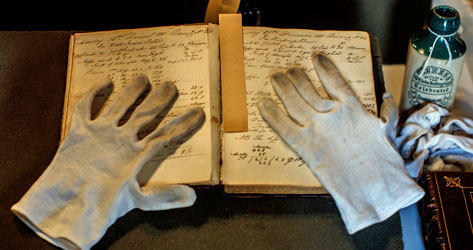- GUINNESS: The secrets of the factory where four million pints a day come out
- GASTRONOMY. The 12 best rice fields in Levante
In the visitor center of the Guinness historical archive there are always white cotton gloves. They are for Eibhlin Colgan, the manager of the archive, and his team to manipulate the historical documents of the fund, some of them with more than two and a half centuries of life. From that same room you can glimpse the document that Arthur Guinness signed in 1756 to rent the Saint James Gate brewery. It is located on the floor of the entrance of the StoreHouse, the museum that the brewery has in Dublin, protected by a thick methacrylate.
Fortunately, it is only a facsimile that millions of museum visitors photograph incessantly. The original document - a sheet of vellum of 62x52 centimeters with the signature and sealed seal of the Irish - is carefully protected and only comes to light on very rare occasions. The last time, when Queen Elizabeth II visited the facilities of the brewery, in 2011.
Not only is it the document related to the oldest brewer in the archive, it is also the most valuable. It contains one of the hallmarks of the brewer, the signature of its founder. That contract is just one of the tens of thousands of items that Colgan and his team collect, document, manage and classify. On one side of the visiting room, several showcases house dozens of bottles and cans. Most of them are special editions, local or commemorating a specific event, such as the 250 years of the brand. All of them hang their corresponding identification tag.
On the living room table a ceramic bottle contrasts with one of the last -and colorful- special cans. A sample of the evolution of the brand's packaging, which has placed its beer even in a smaller bottle than the index finger of an adult's hand.
Books, photographs and labels
In addition to packaging, the registry has 3,000 accounting books , 10,000 photographs, thousands of objects related to the brand and more than a thousand films and videos. "Lined up would occupy seven kilometers," Colgan explains. Among those items, a few deserve special attention. These are the recipe books in which Guinness pointed out the ingredients and processes to get his beers. Like the West Indies Porter, who have re- cooked more than 200 years after their first recipe, dated, according to the book Eibhlin carefully holds, on Monday, December 14, 1801. Two centuries later, it is on sale again, although at the moment only in Ireland.
The contents of the bottles not only have historical inspirations . The labels also remind of past times. Eibhlin and his team guard several books where thousands of brand labels are stored. Many of them come from hundreds of pubs across the country, when the brand was embroiling its beer and the pubs were responsible for bottling it. Each pub included its name on the label, always specifying that it was Guinness beer. Later it was Guinness herself who bottled and canned the beer.
Irish culture
The Irish brewer also bet heavily on advertising and marketing . In 1928 British illustrator John Gilroy was inspired by a zoo show to draw a sea lion holding a beer. It would be the first of the animals that would form the Guinness universe. Lions, ostriches, crocodiles or penguins are some of them, although the most famous is the toucan , which first appeared in 1935. Gilroy was responsible for these drawings until the 1960s. The original sketches are preserved in the archive. The artist's pencil along with cans, bottles and posters where his work was reflected.
The influence of the brand on Irish culture is unquestionable and is present in the archive. At the beginning of the 20th century, the company was the private company with the most workers in the country and its contribution to the national economy was very significant. In addition, it is an important academic source. "Economic and social historians use the archive to complement national records of important cultural and economic events," Colgan notes. It is so important that "it is recognized worldwide as an Irish brand," says Colgan.
The file does not actively search for new items. "The collection is quite complete," says Cogan. However, the company is so linked to the country that they continue to receive new ones as they appear in old houses or in reforms in which material that was believed lost or lost is recovered. The last incorporation has been a book of 70s donated by an employee after three decades of work in the company.
Previously, he also added to his archives some bottles with messages inside that the company launched into the ocean in 1954 commemorating its 200 years of life . Half a century later they still appear on the other side of the puddle. "The last one I know of appeared on the coast of Nova Scotia (Canada) in May 2017," Colgan confirms. However, "the person who found the bottle kept it and did not donate it to the archive," says the archivist. Because, who wouldn't want to keep a piece of the history of one of the oldest beers in the world?
According to the criteria of The Trust Project
Know more- Travels
- tourism
- Europe
- Gastronomy
GastronomyThe new address in Almería to eat a good rice next to the beach
EXPERIENTIAL The latest in Japan: eating at a ninja restaurant
EuropaZadar: the Croatian destination without crowds to enjoy the most authentic Mediterranean

